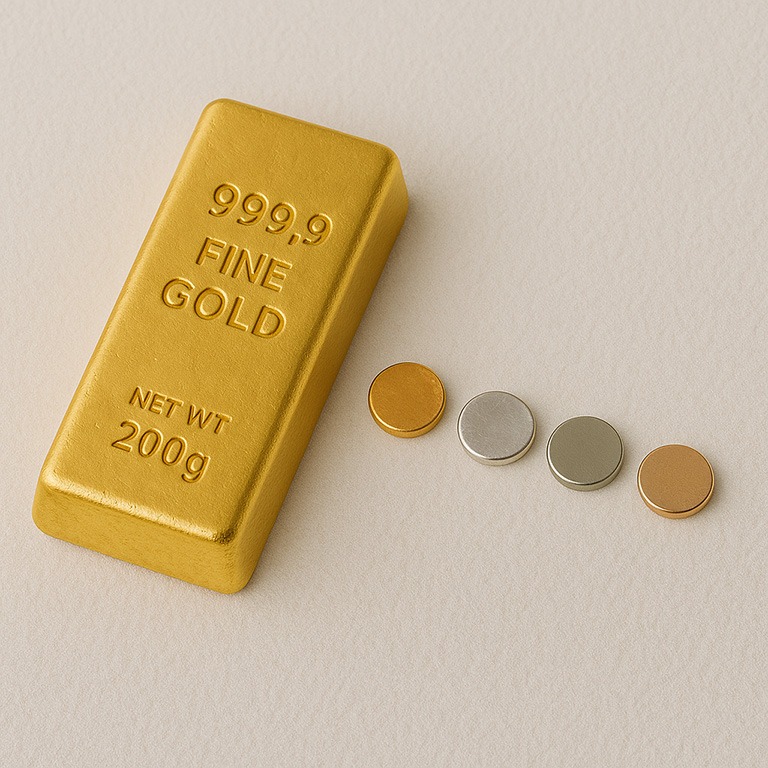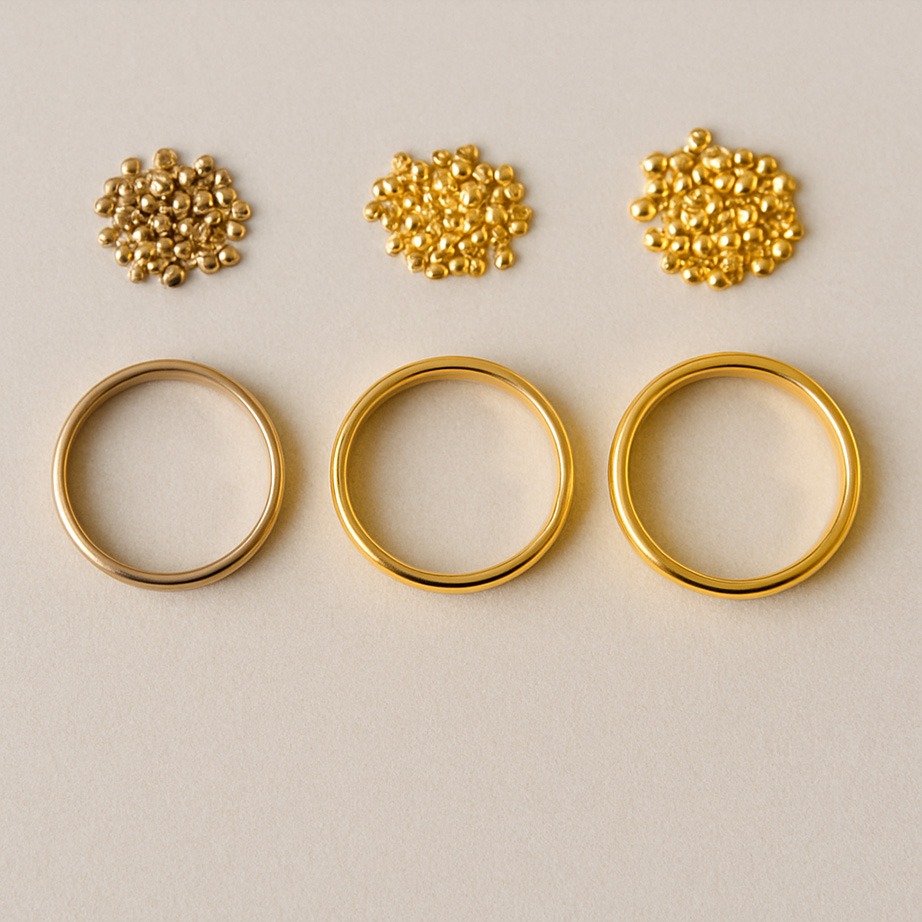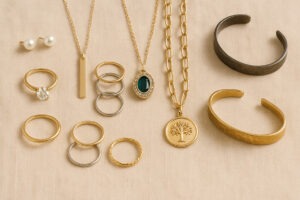When it comes to purchasing fine jewelry, understanding the difference between 14K, 18K, and 24K gold is essential. At Hendrickson’s Fine Jewelry, we know that choosing the right gold purity for your engagement ring, wedding band, or custom piece can feel overwhelming. That’s why we’ve created this comprehensive guide to help you make an informed decision that matches your style, lifestyle, and budget.
What Does “Karat” Mean?
Before we dive into the differences, let’s clarify what “karat” means in gold jewelry. The term “karat,” often abbreviated as “K” or “kt,” refers to the purity of gold. Pure gold is 24 karats. However, pure gold is naturally soft and malleable, making it less suitable for everyday wear. To improve its strength and durability, gold is often alloyed with other metals such as copper, silver, nickel, or zinc.
Understanding Gold Purity
- 24K Gold: 99.9% pure gold
- 18K Gold: 75% pure gold, 25% other metals
- 14K Gold: 58.3% pure gold, 41.7% other metals
The higher the karat number, the greater the gold content. But a higher karat also means the gold is softer, which may not always be the best choice for every piece of jewelry.

- 24K Gold: The Purest Form
24K gold is considered pure gold. It has a rich, vibrant yellow hue that is unmistakable. This type of gold is popular in some cultures for investment, ceremonial, or decorative purposes. However, because 24K gold is soft and malleable, it is rarely used for everyday jewelry in the United States.
- Pros: Highest purity, hypoallergenic, retains intrinsic value.
- Cons: Very soft, scratches and bends easily, less suitable for rings or pieces exposed to daily wear.
- 18K Gold: The Perfect Balance of Purity and Durability
18K gold contains 75% gold and 25% alloyed metals. It offers a luxurious, warm golden tone that is slightly softer and richer in color than 14K gold. Many high-end jewelry pieces, including engagement rings and fine necklaces, are crafted from 18K gold because it strikes a beautiful balance between purity and practical wearability.
- Pros: Luxurious appearance, high gold content, fairly durable for most jewelry.
- Cons: Slightly softer than 14K gold, higher cost, may still scratch with heavy wear.
- 14K Gold: Durability and Affordability Combined
14K gold is made of 58.3% pure gold and 41.7% alloyed metals. This composition makes it significantly stronger and more resistant to scratching, making it a top choice for those who lead active lifestyles or want jewelry that can withstand daily wear. Most engagement rings and wedding bands in the United States are crafted from 14K gold, and it is available in a variety of colors, including yellow, white, and rose gold.
- Pros: Highly durable, more affordable, versatile for all types of jewelry, available in multiple gold colors.
- Cons: Slightly less rich in color compared to higher karat golds, contains more alloy metals (may cause allergies in sensitive individuals).

Which Gold Karat Is Right for You?
Deciding between 14K, 18K, and 24K gold depends on several factors, including your personal style, how you plan to wear the jewelry, and your budget.
Consider Your Lifestyle
If you’re looking for an engagement ring or wedding band that you’ll wear every day, 14K gold is an excellent choice due to its durability. For special occasion pieces or heirlooms, 18K gold offers a richer color and higher gold content. 24K gold is best reserved for collectible pieces or jewelry that won’t be subjected to daily wear and tear.
Think About Allergies
Individuals with sensitive skin may prefer higher karat gold, such as 18K or 24K, because they contain fewer alloy metals. However, most quality gold jewelry, even in 14K, is designed to minimize allergic reactions.
Budget Considerations
As gold purity increases, so does the price. 14K gold is typically the most budget-friendly option, offering both beauty and strength. 18K gold provides a touch of luxury at a higher price point, while 24K gold, being the purest, is the most expensive per gram.
Popular Gold Colors: Yellow, White, and Rose
The color of gold jewelry isn’t determined solely by its karat. The metals used in the alloy also influence the final hue:
- Yellow Gold: Classic, warm, and timeless. The purest reflection of gold’s natural color.
- White Gold: Mixed with metals like nickel or palladium and often plated with rhodium for a bright, silvery finish.
- Rose Gold: Contains copper, giving it a romantic pinkish hue.
All three colors are available in 14K and 18K varieties at Hendrickson’s Fine Jewelry.
Frequently Asked Questions
Is higher karat gold always better?
Not necessarily. While higher karat gold contains more pure gold, it is softer and less durable. The best choice depends on your needs and preferences.
Can I resize or repair jewelry made from 18K or 24K gold?
Yes, but higher karat gold is softer and may require specialized techniques. Our expert jewelers at Hendrickson’s have decades of experience handling all types of gold jewelry.
Which gold is best for custom jewelry?
Both 14K and 18K gold are excellent choices for custom pieces. 14K gold offers superior durability, while 18K gold provides luxurious color and beauty.
Trust Hendrickson’s Fine Jewelry for Your Gold Jewelry Needs
Whether you’re shopping for a classic wedding band, a custom engagement ring, or a meaningful anniversary gift, understanding the differences between 14K, 18K, and 24K gold will help you make a confident, informed choice. At Hendrickson’s Fine Jewelry, we are proud to offer a curated selection of gold jewelry from top designers and provide expert guidance for all your jewelry decisions.
Stop by our showroom at 5685 N Glenwood St in Garden City, Idaho, or (208) 853-1615 to speak with one of our knowledgeable team members. With over 1000 five-star reviews, you can trust us to help you find or create the perfect piece to cherish for a lifetime.
References
“Gold Jewelry: What to know About buying gold jewelry.” By Jewlers of America
“Is Gold Jewelry a Good Investment?” By World Gold Council




